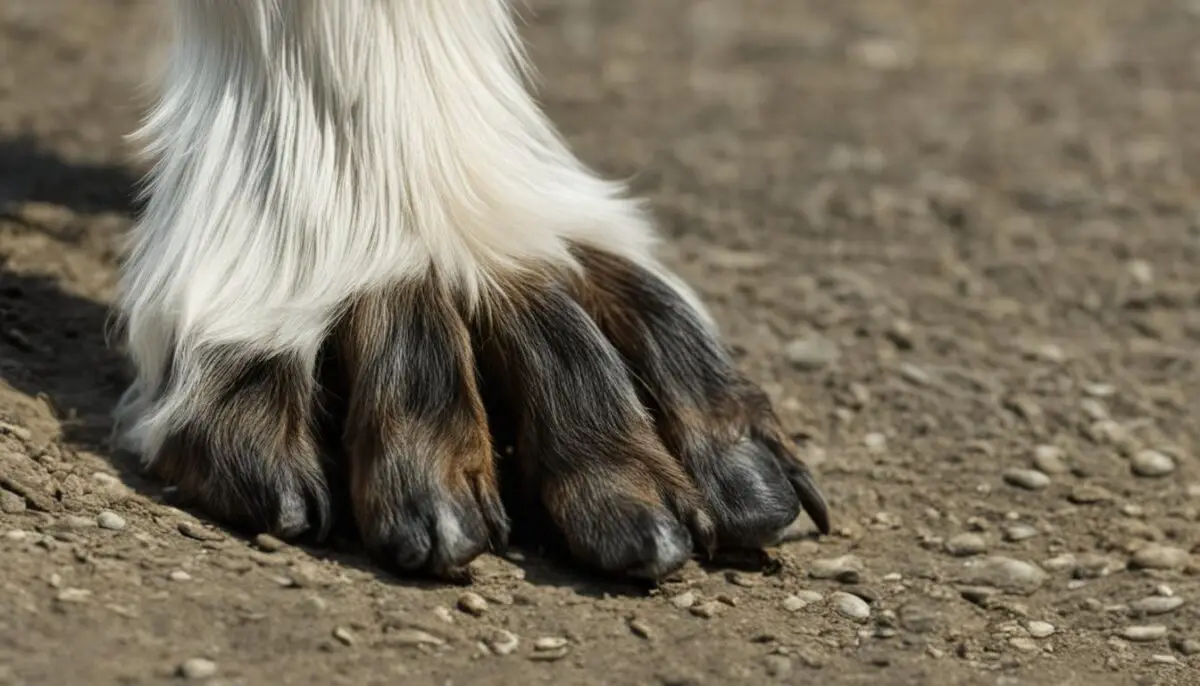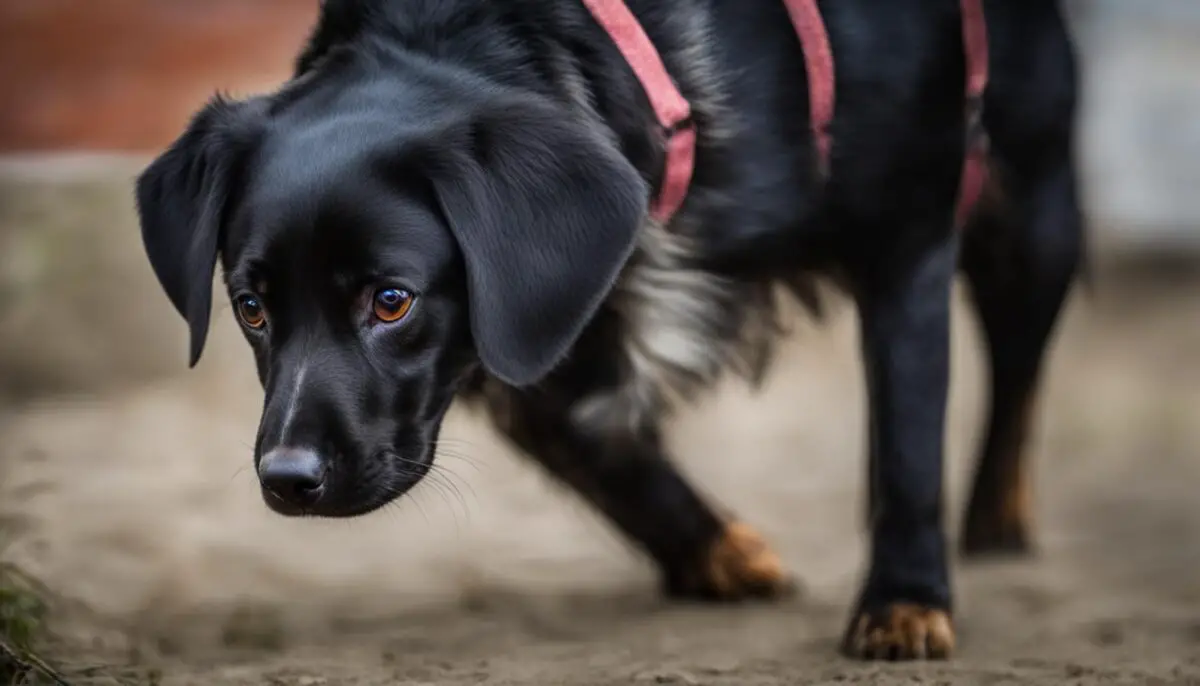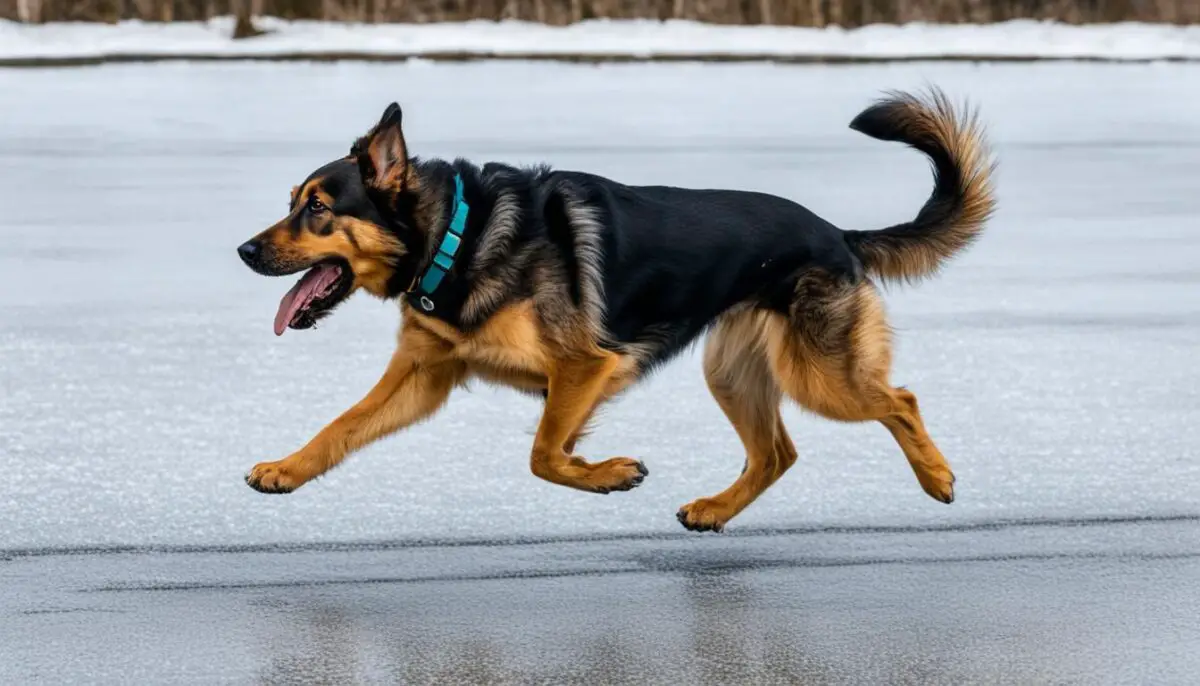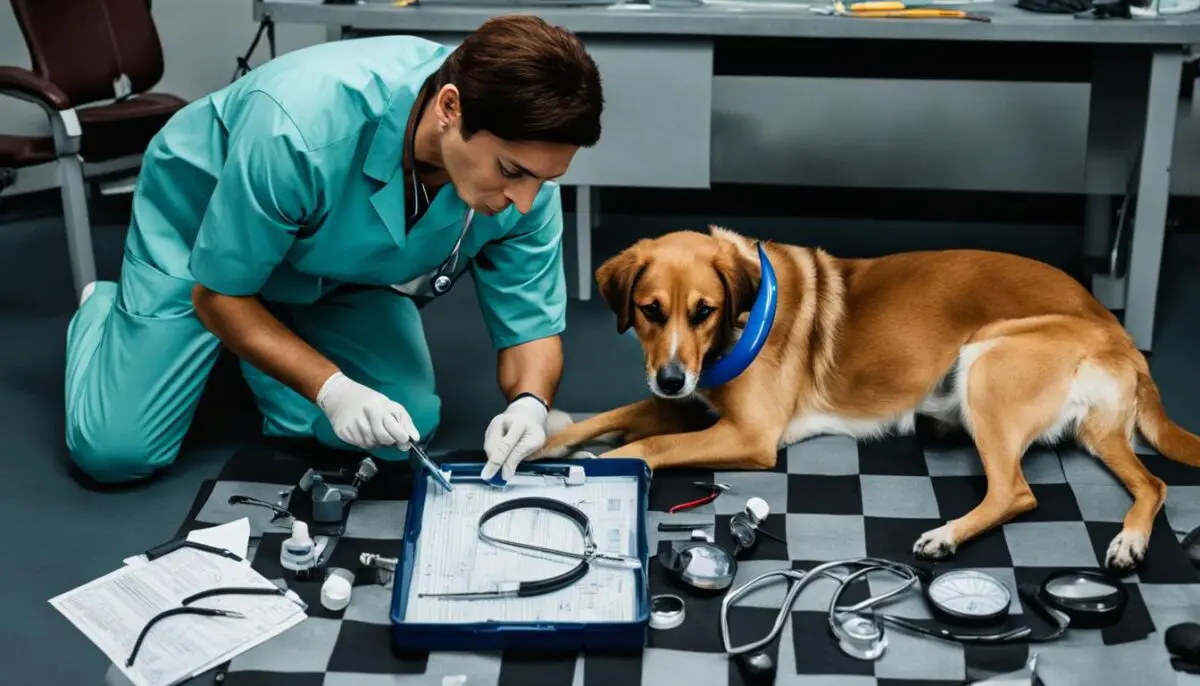Is your canine companion exhibiting signs of discomfort in their hind legs? Dogs are prone to hind leg injuries, which can cause pain and affect their overall mobility. It is crucial for pet owners to be aware of the symptoms of hind leg injuries so that prompt care and treatment can be provided. By recognizing the signs early on, you can ensure that your furry friend receives the necessary care and attention they need.
Key Takeaways:
- Limping is often one of the first signs of a hind leg injury in dogs.
- Swelling and redness around the injured leg may indicate a moderate to severe sprain.
- Dogs in pain may exhibit hiding, whining, and loss of appetite.
- Unwillingness to run or jump and increased focus on licking and chewing the injured leg are common signs.
- Consulting a veterinarian is essential for proper diagnosis and treatment of hind leg injuries in dogs.
Types of Hind Limb Injuries in Dogs
Hind limb injuries in dogs can occur in different areas, including the ankles, knees, and hips. These injuries can cause pain, lameness, and mobility issues for your furry friend. Here are some common types of hind leg injuries to look out for:
- Achilles Tendon Injury: This occurs when the Achilles tendon in the ankle is stretched or torn. It can cause pain and difficulty in walking.
- Sprains & Strains: These injuries affect the ligaments and tendons in the hind legs. They can lead to lameness and discomfort for your dog.
- Tarsal Fractures: Fractures in the tarsal bones of the foot can result from trauma or repetitive actions. They cause pain and swelling in the affected area.
- Slipped Hock: This injury affects the hock joint, which is equivalent to the human ankle. It can cause instability and mobility issues for your dog.
- Cranial Cruciate Ligament (CCL) Injury: The CCL helps stabilize the knee joint. A torn CCL can lead to lameness and arthritis.
- Hip Dysplasia: This is a genetic condition that affects the hip joint. It causes pain and reduced mobility.
- Hip Luxation: Hip luxation occurs when the hip joint becomes dislocated. It causes severe pain and difficulty in bearing weight.
- Pelvic Fractures: Fractures in the pelvic bones can result from trauma and cause lameness and pain.
If you notice any symptoms of hind leg injury in your dog, such as limping, swelling, or difficulty in walking, it’s important to consult a veterinarian for proper diagnosis and treatment.

How to Tell if Your Pet Has a Hind Limb Injury
It can be challenging to determine if your pet has a hind limb injury, but there are signs to watch out for:
- Muscle Weakness and Atrophy: The affected leg may appear weaker and smaller than usual.
- Lameness and Limping: Your dog may limp or have difficulty bearing weight on the injured leg.
- Swelling and Bruising: Injuries to the hind limb may cause swelling, bruising, and increased warmth around the affected area.
- Pain and Guarding: Your pet may exhibit signs of pain, such as vocalization or reflexive guarding when the injured leg is touched.
- Decreased Range of Motion: Hind limb injuries can limit your dog’s range of motion and make movement difficult.
- Clicking or Crepitus: You may hear clicking or cracking sounds in the leg during gait or movement.
If you notice any of these symptoms, it’s important to consult a veterinarian for a proper diagnosis and treatment.

| Hind Limb Injury Symptoms | Indicators of Hind Limb Injury |
|---|---|
| Muscle Weakness and Atrophy | Leg appears weaker and smaller |
| Lameness and Limping | Difficulty bearing weight on the leg |
| Swelling and Bruising | Increased warmth, bruising, and swelling |
| Pain and Guarding | Vocalization or reflexive guarding when touched |
| Decreased Range of Motion | Limited range of motion and difficulty in movement |
| Clicking or Crepitus | Clicking or cracking sounds during gait |
Common Causes of Hind Limb Injuries in Dogs
When it comes to hind limb injuries in dogs, there are several common causes that pet owners should be aware of:
- Trauma: Falls, accidents, and physical impact can lead to hind leg injuries. Dogs can easily injure their hind limbs while running, playing, or exploring their surroundings.
- Overexertion: Excessive exercise or repetitive actions can strain the muscles and ligaments in the hind legs. Dogs that participate in high-impact activities like agility training or strenuous exercise may be at a higher risk.
- Congenital Abnormalities: Certain breeds may be more prone to hind leg injuries due to genetic factors. For example, breeds predisposed to hip dysplasia are more susceptible to hip-related injuries.
- Arthritis: Joint inflammation and degeneration can contribute to hind limb injuries and pain. Dogs with arthritis may experience increased wear and tear on their joints, making them more susceptible to injuries.
- Weight Issues: Excessive weight can put added stress on the hind legs and increase the risk of injuries. Overweight or obese dogs are more prone to musculoskeletal problems, including hind leg injuries.
- Underlying Health Conditions: Certain diseases and conditions can affect a dog’s joints and increase the risk of hind limb injuries. For example, conditions like osteoarthritis or parasite-borne illnesses can weaken the joints and make them more susceptible to injury.
Understanding the causes of hind limb injuries can help pet owners take proactive steps to prevent them and ensure the well-being of their canine companions.

How Are Hind Limb Injuries Diagnosed?
Diagnosing hind limb injuries in dogs requires a comprehensive examination by a skilled veterinarian. To accurately assess the extent of the injury, the diagnostic process may include:
- Physical Examination: The veterinarian will carefully inspect the affected leg, evaluate its strength, and observe your pet’s gait for any abnormalities.
- Imaging Tests: X-rays, CT scans, or MRI may be conducted to obtain detailed images of the bones, joints, and soft tissues in the hind limb.
- Lab Work: Blood tests or joint fluid analysis may be performed to rule out the presence of underlying conditions or infections that could contribute to the injury.
- Specialist Consultation: In complex cases, the veterinarian may refer your pet to an orthopedic specialist for further evaluation and treatment recommendations.
Early and accurate diagnosis is of utmost importance to ensure appropriate treatment and effective management of hind limb injuries in dogs.

Diagnostic Methods for Hind Limb Injuries in Dogs
| Diagnostic Method | Description |
|---|---|
| Physical Examination | A thorough assessment of the affected leg, strength testing, and gait observation. |
| Imaging Tests | X-rays, CT scans, or MRI to visualize bones, joints, and soft tissues. |
| Lab Work | Blood tests or joint fluid analysis to rule out underlying conditions or infections. |
| Specialist Consultation | Referral to an orthopedic veterinarian for further evaluation and treatment recommendations. |
Treating Hind Limb Injuries in Dogs
The treatment for hind limb injuries in dogs is essential for alleviating pain, promoting healing, and restoring mobility. The specific treatment plan depends on the nature and severity of the injury, as well as your dog’s individual needs. Here are some common treatment options for managing hind limb injuries in canines:
- Rest and Restriction: Limiting your dog’s activity and providing a quiet, confined space for recovery can promote healing. It is crucial to restrict your dog’s movements to prevent further injury.
- Medications: Pain relievers and anti-inflammatory drugs may be prescribed by your veterinarian to alleviate discomfort and reduce inflammation. These medications can help manage pain and facilitate the healing process.
- Surgery: In some cases, surgical intervention may be necessary to repair fractures, torn ligaments, or dislocated joints. Your veterinarian will assess the injury and determine if surgical treatment is the best option for your dog’s recovery.
- Physical Therapy: Rehabilitation exercises, hydrotherapy, and other modalities can help improve strength and mobility in the hind limbs. Physical therapy sessions may include exercises to increase muscle strength, joint mobility, and overall fitness.
- Weight Management: Maintaining a healthy weight is crucial for preventing further stress on the hind legs. Your veterinarian may recommend a diet and exercise plan to help your dog achieve and maintain a healthy weight.
- Joint Supplements: Supplements like glucosamine and omega-3 fatty acids may be recommended to support joint health. These supplements can aid in reducing inflammation, promoting cartilage health, and improving joint mobility.
By combining these treatment options and following the guidance of your veterinarian, you can provide your dog with the best care and support during their recovery from hind limb injuries.
Conclusion
Recognizing the symptoms of hind leg injuries in dogs is crucial for their well-being and overall quality of life. If you notice any signs of limping, swelling, pain, or mobility issues in your pet’s hind legs, it is important to consult a veterinarian. By seeking prompt diagnosis and appropriate treatment, you can alleviate their pain, promote healing, and support their recovery.
It is vital to follow the recommended treatment plan provided by the veterinarian, ensuring your dog receives the necessary rest and restrictions during their recovery process. Your support and care are essential in helping your dog regain their mobility and improve their overall condition.
With proper interventions and attentive care, most dogs can successfully recover from hind limb injuries. Remember that each dog’s journey is unique, and their recovery may take time. By providing them with the required treatment, care, and attention, you can help them regain their strength and lead a happy, active life.
FAQ
What are the symptoms of a hind leg injury in dogs?
The symptoms of a hind leg injury in dogs may include limping, swelling, hiding and whining, unwillingness to run or jump, loss of appetite, and excessive licking or chewing of the injured leg.
What are the common types of hind limb injuries in dogs?
Common types of hind limb injuries in dogs include Achilles tendon injuries, sprains and strains, tarsal fractures, slipped hocks, cranial cruciate ligament (CCL) injuries, hip dysplasia, hip luxation, and pelvic fractures.
How can I tell if my dog has a hind limb injury?
Signs of a hind limb injury in dogs may include muscle weakness and atrophy, lameness and limping, swelling and bruising, pain and guarding, decreased range of motion, and the presence of clicking or crepitus sounds during movement.
What are the common causes of hind limb injuries in dogs?
Hind limb injuries in dogs can be caused by trauma, overexertion, congenital abnormalities, arthritis, weight issues, and underlying health conditions.
How are hind limb injuries diagnosed in dogs?
Hind limb injuries in dogs are diagnosed through a combination of physical examinations, imaging tests (such as X-rays or CT scans), lab work (such as blood tests or joint fluid analysis), and sometimes consultation with a specialist.
How are hind limb injuries treated in dogs?
Treatment for hind limb injuries in dogs can include rest and restriction, medications for pain relief and inflammation reduction, surgery for more severe injuries, physical therapy for rehabilitation, weight management, and the use of joint supplements.


